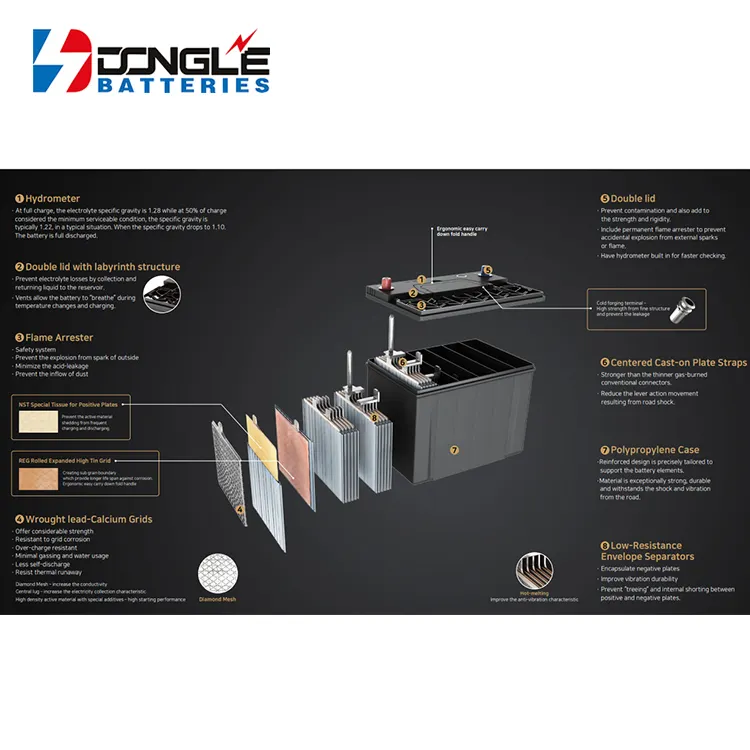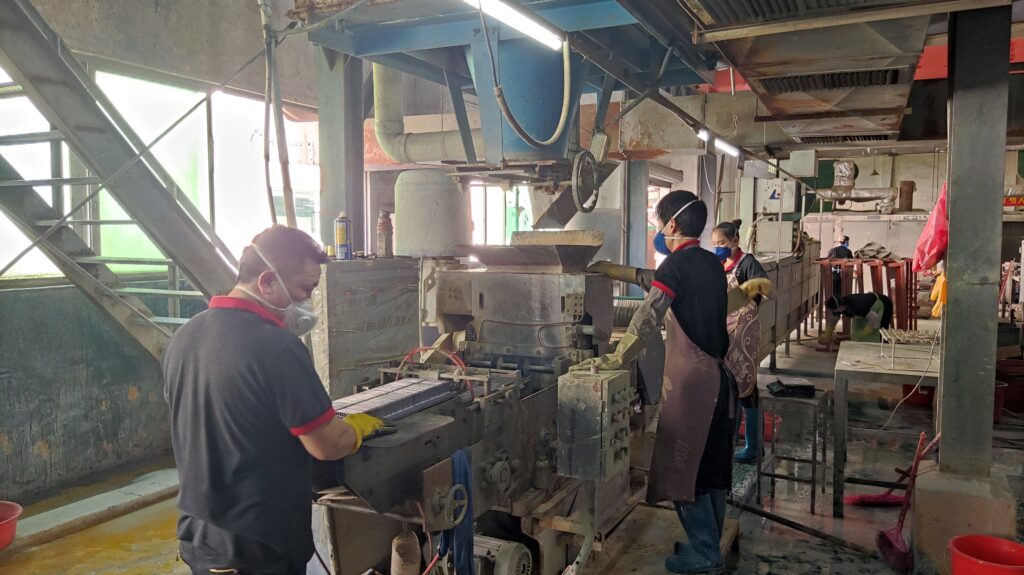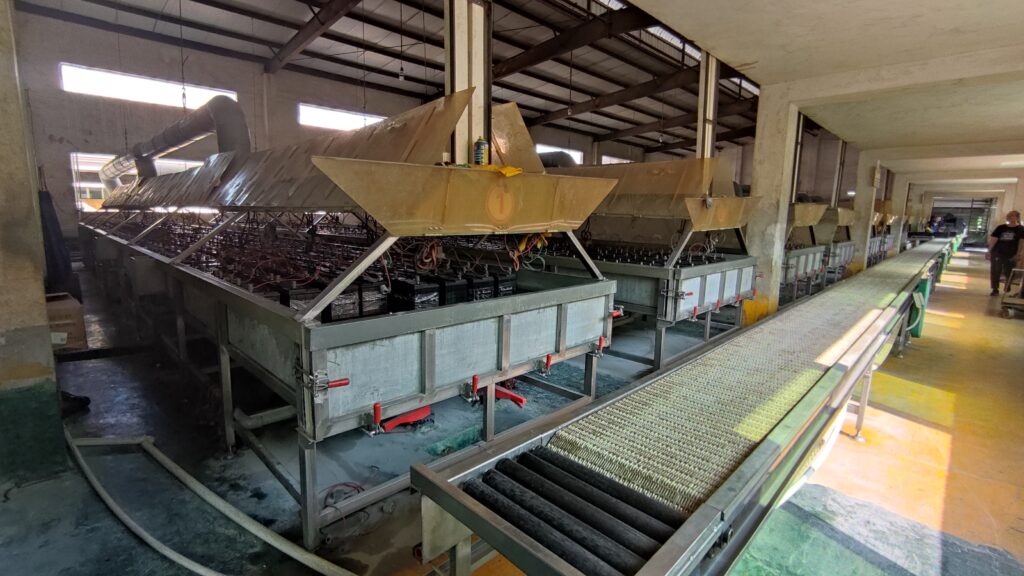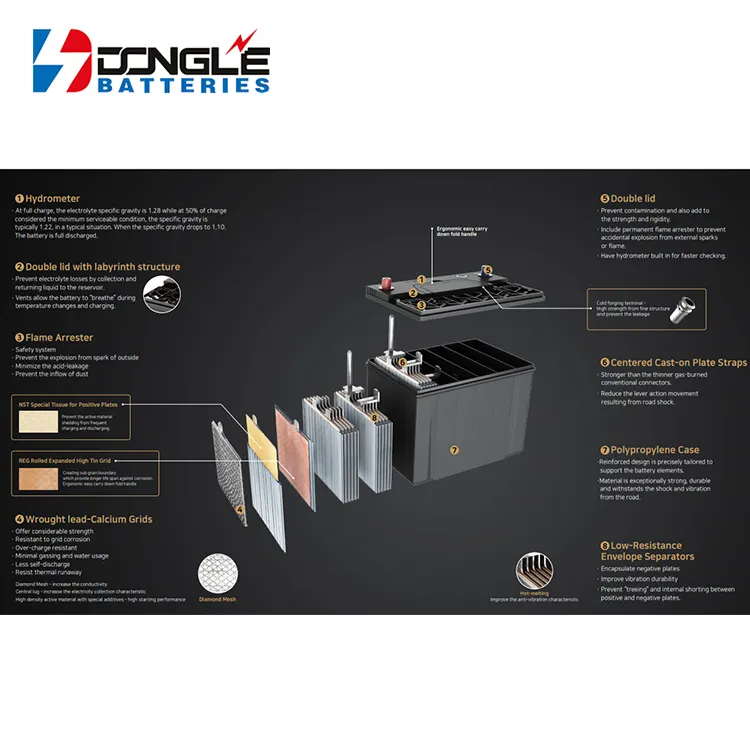A lead-acid car battery is a battery whose electrodes are mainly made of lead and its oxides, and the electrolyte is a sulfuric acid solution. In the discharge state of the lead-acid battery, the main component of the positive electrode is lead dioxide, and the main component of the negative electrode is lead; in the charging state, the main component of the positive and negative electrodes is lead sulfate. Used in the starting of car engines. The main advantages are durability and low cost, and it is an irreplaceable product for car starting at present.

How lead-acid batteries work?
The active material of the positive electrode of the lead-acid battery is lead dioxide, the active material of the negative electrode is lead sponge, and the electrolyte is a dilute sulfuric acid solution. +PbO2 (positive electrode)+2H2SO4====2PbSO4+2H2O (discharge reaction), the charging chemical reaction is that lead sulfate and water are converted into lead dioxide, sponge lead and dilute sulfuric acid. 2PbSO4+2H2O====Pb (negative pole) + PbO2 (positive pole) + 2H2SO4 (charging reaction) The rated voltage of a single lead-acid battery is 2.0V, and it is generally connected in series to 6V and 12V. It is used for starting lighting of automobiles and motorcycles. Single batteries are generally connected in series for 48V, 96V, 110 or 220V for different occasions. The positive and negative plates in the battery use rubber, PVC, PE or AGM separators with extremely low resistance, few impurities and stable ions to pass through.
Lead-acid battery process and main equipment
Lead powder manufacturing, grid casting, plate manufacturing, plate formation, battery assembly
Lead powder manufacturing equipment: casting machine or section cutting machine, lead powder machine and transportation and storage system;
Grid casting equipment: lead melting furnace, casting machine and various molds;
Plate manufacturing equipment: paste machine, smear machine, surface drying, curing drying system, etc.;
Electrode forming equipment: charging and discharging motor;
Water-cooled chemical and environmental protection equipment;
Assembly battery equipment: automobile battery, motorcycle battery, large, medium and small sealed valve-regulated lead-acid battery assembly line
Battery testing equipment: various battery performance testing.

Typical lead-acid battery process overview
Lead-acid batteries are mainly composed of battery tanks, battery covers, positive and negative plates, dilute sulfuric acid electrolyte, separators and accessories. The manufacturing process is briefly described as follows:
Lead powder manufacturing: the 1# electrolytic lead special equipment lead powder machine is oxidized and screened to make lead powder that meets the requirements.
Grid casting: lead-antimony alloy, lead-calcium alloy or other alloy lead is usually cast into different types of grids that meet the requirements by gravity casting.
Electrode plate manufacturing: mix lead powder with dilute sulfuric acid and additives, apply it on the surface of the grid, and then dry and solidify it to form a green electrode plate.
Formation of polar plates: The positive and negative plates react with dilute sulfuric acid under the action of direct current to produce lead oxide, and then after cleaning and drying, the positive and negative plates can be used for battery assembly.
Assembling batteries: Assemble different types of plates with different numbers of plates into various types of batteries according to different needs.
Note: Each unit can choose different processes due to different process conditions.
Introduction to Grid Casting
The grid is the carrier of the active material and also the current collector of electricity.
Ordinary open battery grids are generally cast with lead-antimony alloys, maintenance-free battery grids are generally cast with low-antimony alloys or lead-calcium alloys, and sealed valve-regulated lead-acid battery grids are generally cast with lead-calcium alloys.
Step 1: Determine the type of alloy lead according to the battery type and put it into the lead furnace to heat and melt it. After meeting the process requirements, cast the lead liquid into the metal mold. After cooling, the mold is removed and stacked.
Step 2: After a certain period of aging, the trimmed grid can be transferred to the next process.
Grid main control parameters: grid quality; grid thickness; grid integrity; grid geometry, etc.;
Introduction to Lead Powder Manufacturing
Lead powder is produced by Shimadzu method and Barton method, and the result is that 1# electrolytic lead is processed into lead powder that meets the requirements of battery production technology. The main components of lead powder are lead oxide and metallic lead. The quality of lead powder has a very close relationship with the quality of the manufactured product. In my country, the Shimadzu method is often used to produce lead powder, while in Europe and America, the Barton method is often used to produce lead powder.
The process of producing lead powder by Shimadzu method is briefly described as follows:
Step 1: Process the qualified electrolytic lead through casting or other methods into lead balls or lead segments of a certain size;
Step 2: put the lead ball or lead segment into the lead powder machine, the lead ball or lead segment is oxidized to produce lead oxide;
The third step: Put the lead powder into the designated container or powder storage bin, after 2-3 days of aging, it can be used after passing the test.
Main control parameters of lead powder: degree of oxidation; apparent density; water absorption; particle size, etc.;
Introduction to Plate Manufacturing
The pole plate is the core part of the battery, and its quality directly affects various performance indicators of the battery. The production process of paste-coated plates is briefly described as follows:
The first step: make the lead powder, dilute sulfuric acid and additives that pass the test into lead paste with special equipment;
The second step: apply the lead paste to the grid with a smear machine or by hand;
Step 3: Curing and drying the filled plate to obtain the green plate.
The main control parameters of the raw plate: lead paste formula; apparent density; acid content; paste amount; thickness; free lead content; moisture content, etc.
Introduction to assembly process
There is a big difference in battery assembly between automotive batteries and sealed valve-regulated lead-acid batteries. Sealed valve-regulated lead-acid batteries require tight assembly and generally use AGM separators, while automotive batteries generally use PE, PVC or rubber separators. The assembly process is briefly described as follows:
The first step: put the qualified plate into the welding tool according to the process requirements;
Step 2: Put the cast-welded or hand-welded electrode group into the clean battery slot;
Step 3: The car battery needs to be through-wall welded and heat-sealed, and the sealed valve-regulated lead-acid battery needs to be bonded with a special adhesive if it uses an ABS battery tank.
The main control parameters of battery assembly: busbar welding quality and material; sealing performance, positive and negative polarity, etc.
Brief Introduction of Chemical Formation Process
Plate formation and battery formation are two different methods of battery manufacturing, which can be selected according to specific conditions. The plate formation is generally relatively easy to control and the cost is high, and the environmental pollution needs special treatment. It is difficult to control the quality of battery formation. Generally, the quality of the raw plates produced is relatively high, but the cost is relatively low. The formation of sealed valve-regulated lead-acid batteries is briefly described as follows:
The first step: put the qualified raw plate into the battery tank according to the process requirements and seal it;
The second step: pour a certain concentration of dilute sulfuric acid into the battery according to the specified amount;
Step 3: After being placed, direct current is passed according to the size according to the regulations. Generally, after formation, discharge inspection is required, and then put into storage and ready to leave the factory.
Main control parameters of battery formation: tank acid volume; tank acid density; tank acid temperature; charging capacity and time, etc.

How to use and maintenance?
Lead-acid batteries play an irreplaceable role in secondary chemical power sources due to their simple manufacturing process, abundant sources of raw materials, and moderate prices. In particular, the emergence of valve-regulated batteries has revitalized traditional batteries. The service life of the battery is closely related to the manufacture, and also has a great influence on the method of use. Correct use of the method is of great benefit to prolonging the life of the battery. For traditional open-type batteries, the following aspects must be paid attention to daily:
- Pay attention to the quantity, density and charging degree of the electrolyte, especially the charging system closely related to it. If the charging capacity is large, the battery will lose a lot of water, which will easily cause the active material of the plate to fall off, resulting in a short circuit at the bottom. The internal temperature of the battery is high and the life is shortened. If the charging capacity is small, it is easy to cause the battery to lose power. In the case of long-term power loss, the battery can lead to irreversible sulfation of the plate, which is manifested by a rapid rise in the voltage during the charging process. , completed in a very short time, and the voltage drops rapidly when discharging.
- The purity of the electrolyte is generally filled with a battery-specific electrolyte or supplementary solution, and it is strictly forbidden to replace it with ordinary sulfuric acid and tap water.
- The daily use surface is kept clean and the exhaust port is unblocked.
- When not in use, it should be fully charged first, and a supplementary charge should be carried out every three months.
For sealed valve-regulated lead-acid batteries, the following aspects must be paid attention to daily:
- Pay attention to the range of charging voltage. The voltage is generally controlled at 2.15±0.1V/cell during floating charging, and the voltage is generally controlled at 2.35±0.1V/cell during cycle use. If required by the manual, it should be operated according to the manual.
② Pay attention to the ambient temperature, generally not more than 30 degrees is appropriate. When the temperature changes greatly, the adjustment of the voltage should be strengthened.
- Products from different manufacturers cannot be mixed, and old and new products from the same manufacturer cannot be mixed.
④ It is best not to open the lid of the sealed valve-regulated lead-acid battery to replenish the electrolyte and replace the safety valve.



